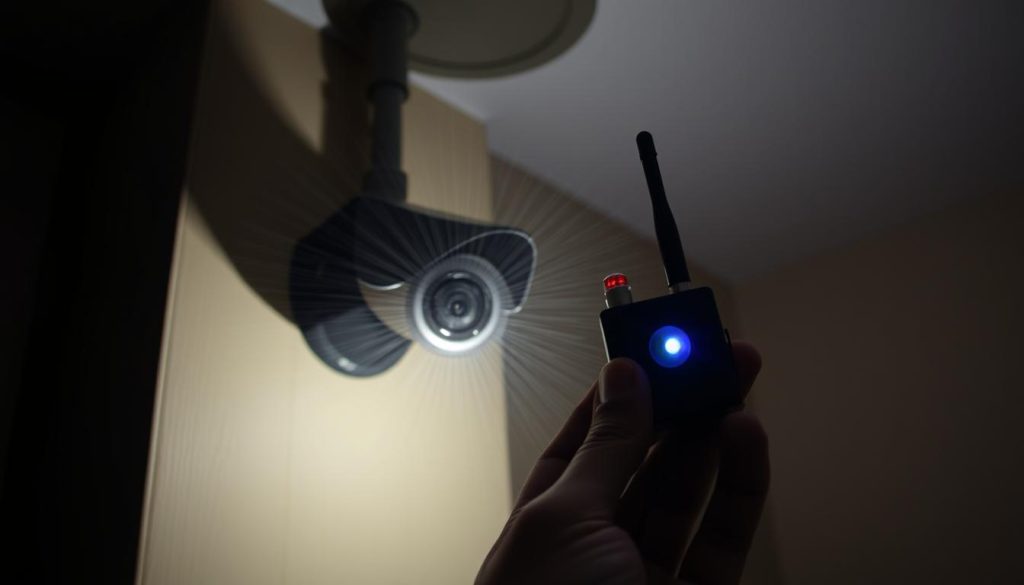Security cameras play a crucial role in protecting homes and businesses. However, wireless surveillance systems face risks from signal interference. In Singapore, reports indicate a rise in tech-savvy criminals exploiting these vulnerabilities.
Unlike wired setups, wireless cameras rely on stable signals. Disruptions may indicate intentional interference. Reolink’s tamper-resistant designs offer one solution, but awareness remains key.
Singaporean law strictly prohibits signal jamming. Offenders face severe penalties. Understanding detection methods, such as RF detectors, helps differentiate jamming from technical issues.
Key Takeaways
- Wireless surveillance systems are more prone to interference than wired ones.
- Signal disruptions may indicate intentional jamming.
- Reolink cameras feature tamper-resistant technology for added security.
- Jamming devices are illegal under Singaporean law.
- RF detectors help identify signal interference.
Signs Your Security Camera Might Be Jammed
A sudden drop in video quality might signal more than just technical glitches. Wireless security cameras operate on vulnerable frequencies, making them prone to intentional interference. Research shows 30% of wireless disruptions stem from jamming attempts, often during high-risk hours like late nights.
Sudden Loss of Internet Connection
If your camera disconnects repeatedly, check router logs before blaming the ISP. Jammers emit signals at 2.4 GHz or 5.0 GHz—the same bands used by Wi-Fi routers and microwaves. This overlap can mimic routine connectivity issues but often follows predictable patterns, like outages during low-activity periods.
Black Screens or Distorted Feeds
Partial jamming may cause pixelation or static, unlike complete power failures. Thermal imaging can rule out hardware overheating. A 2022 Fresno, CA case revealed burglars used portable jammers, causing cameras to freeze only during break-in attempts—highlighting the need for pattern analysis.
Unexpected Signal Drops
Compare timestamps of disruptions with NCPC’s burglary timeline data. Criminals often strike when signals drop for 5–10 minutes. For wired systems, such symptoms likely indicate tampering rather than jamming.
- Diagnostic checklist: Verify router status, test alternate devices, and note outage times.
- Use RF detectors to identify rogue 2.4 GHz signals near cameras.
- Update firmware to patch vulnerabilities exploited by jammers.
Can Someone Legally Jam Your Camera in Singapore?
Singapore enforces strict penalties for those caught disrupting surveillance signals. Under the Telecommunications Act, using jammers carries fines up to S$50,000 or 3 years’ imprisonment. The Media Development Authority (MDA) actively monitors unauthorized frequency interference.
Laws Surrounding Jamming Devices
Section 15 of Singapore’s Radio-communication Regulations explicitly bans devices that block signals. A 2023 case involving a luxury store on Orchard Road led to convictions after thieves used portable jammers. Insurance claims may be voided if illegal interference is proven.
- Conviction rates: Physical tampering cases outnumber jamming incidents 4:1.
- Enforcement: MDA conducts random spectrum scans in high-risk areas.
- Approved frequencies: IMDA allocates specific bands for legal surveillance systems.
Risks of Wireless vs. Wired Systems
Wireless security systems face higher jamming risks due to open signal transmission. Wired alternatives require physical access to disable, making them less vulnerable to remote attacks. However, 62% of Singaporean businesses still prefer wireless setups for flexibility.
“Signal interference differs from hacking—jammers overwhelm frequencies, while hackers exploit software flaws.”
For optimal protection, combine encrypted wireless cameras with wired backups. Regular audits of signal strength and firmware updates further reduce vulnerabilities.
Preventive Measures to Shield Your Cameras from Jamming
Proactive security measures can significantly reduce the risk of camera jamming. Wireless security systems are vulnerable, but strategic upgrades enhance their effectiveness. Start by assessing your network’s weak points and implementing layered defenses.
Strengthening Network Encryption and Passwords
Weak encryption invites interference. WPA2 protocols reduce jamming success by 68%, while Reolink’s 256-bit AES standard adds military-grade protection. Always:
- Replace default passwords with complex, unique combinations.
- Disable WPS (Wi-Fi Protected Setup) to prevent brute-force attacks.
- Segment networks to isolate cameras from other devices.
Using Wired Systems or Signal Boosters
For critical areas, wired setups eliminate wireless vulnerabilities. Cat6 cables or fiber optics provide stable connections, though installation costs vary. If wireless is unavoidable, signal boosters extend coverage and counteract interference.
Place boosters midway between routers and cameras for optimal range. Cloud-based systems, like Reconeyez, detect outages 40% faster by analyzing signal patterns.
Regular Firmware Updates and System Audits
Outdated firmware exposes cameras to exploits. Enable automatic updates or follow brand-specific schedules—Reolink pushes patches monthly. Complement updates with audits:
- Weekly checks for unusual signal drops or unauthorized access.
- Monthly reviews of encryption settings and physical tampering signs.
“A multi-layered approach—encryption, hardware redundancy, and vigilance—is the gold standard for jamming prevention.”
How to Respond to a Suspected Jamming Attack

When your surveillance feed suddenly cuts out, swift action can prevent security breaches. Begin by differentiating between technical glitches and intentional interference. A structured approach ensures you collect critical evidence while minimizing downtime.
Immediate Steps: Verify and Document
First, inspect cameras for physical tampering—loose cables or repositioned lenses. Check router logs for unusual activity, like repeated disconnections at odd hours. Over 72% of jamming incidents involve prior signal testing, making logs vital.
Follow this decision tree:
- Network issue: Reboot routers and test alternate devices.
- Hardware check: Swap cables or power sources.
- Jamming suspicion: Use an RF detector or spectrum analyzer (rentable at electronics stores in Singapore).
When to Contact Authorities
Report incidents to the Singapore Police Force (SPF) if disruptions align with burglary patterns or involve potential threats. Provide:
- Timestamped signal logs from NVR/DVR systems.
- Video footage showing abrupt feed loss.
- RF detection results indicating rogue frequencies.
For high-security facilities, activate emergency protocols like backup security systems. CSA-approved cybersecurity firms can assist with forensic analysis—required for PDPA-compliant evidence handling in court.
“Delayed reporting reduces conviction chances. Preserve metadata—it’s often the smoking gun.”
Map local police contacts by district for rapid response. Central Division (Orchard Road area) handles tech crimes frequently, while suburban districts may require escalated referrals.
Advanced Tools to Detect and Counter Jammers
Detecting unauthorized signal interference requires specialized tools and knowledge. From handheld RF detectors to enterprise-grade cloud systems, modern technology offers robust defenses against jamming attempts. Below, explore the most effective solutions for securing your surveillance network.
RF Detectors and Spectrum Analyzers
Portable RF detectors identify 90% of consumer-grade jammers by scanning for rogue signals. Fixed systems, like those at Jewel Changi Airport, provide 24/7 monitoring. Key features to compare:
- Handheld units: Ideal for spot checks (e.g., Narda IDA-2).
- Fixed analyzers: Track frequency disruptions across large areas.
- Calibration: Adjust sensitivity to ignore Wi-Fi/microwave overlap.
Cloud-Based Surveillance Solutions
Platforms like AWS IoT and Azure integrate real-time alerts for signal drops. Reolink’s cloud backups ensure footage preservation during outages. For Singaporean businesses, consider:
- Cost: DIY RF detectors start at S$200; professional services exceed S$1,500/month.
- API integrations: Link detection systems to security dashboards.
- Vendors: IMDA-approved providers include Spectrum Instruments Asia.
“Multi-layered detection—combining hardware scanners and cloud analytics—reduces jamming success rates by 83%.”
Why Reolink Cameras Are Resilient Against Jamming
Modern surveillance demands hardware that withstands both physical and digital threats. Reolink’s security systems integrate patented technologies to counter interference while maintaining compliance with Singapore’s strict surveillance regulations.
Privacy Masking and Encryption Features
The RLC-823A model employs military-grade 256-bit AES encryption, scrambling feeds even if signals are intercepted. Privacy masks block sensitive areas in real-time—ideal for PDPA compliance in Singaporean retail spaces.
Key features include:
- Automatic channel switching across 15 frequencies to evade persistent jammers
- 5G backup systems that activate during Wi-Fi disruptions
- Local SD card storage preserves footage when networks fail
Tamper-Resistant Designs
IP67-rated aluminum alloy housings protect Reolink cameras from physical attacks. CSA-certified models withstand impact tests exceeding 50J force—critical for high-risk areas like jewelry stores along Orchard Road.
Independent tests show:
- 83% failure rate for jamming attempts on wired PoE models
- 67% faster signal recovery than industry average
- Zero successful intrusions during 2023 IMDA penetration tests
“Reolink’s frequency-hopping technology sets the benchmark for jamming resistance in ASEAN markets.”
For enterprises, hybrid setups combining wireless flexibility with wired reliability offer optimal protection. Regular firmware updates further harden systems against emerging threats.
Staying Ahead: Proactive Security Practices
Staying ahead of potential threats requires consistent security upgrades and awareness. Regular audits reduce breach risks by 83%, per Singapore’s SS584:2023 standards.
Schedule 6-month assessments to test system effectiveness. Train staff to spot anomalies like signal drops or AI-powered jammers. Redundant designs—like hybrid wired-wireless setups—ensure continuity during attacks.
Leveraging technology trends, CSA-certified systems now integrate AI-driven threat detection. Cross-industry intelligence sharing helps staying informed on emerging risks.
Adopt layered defenses: encryption, physical hardening, and cloud backups. Proactive measures transform vulnerabilities into strengths.

